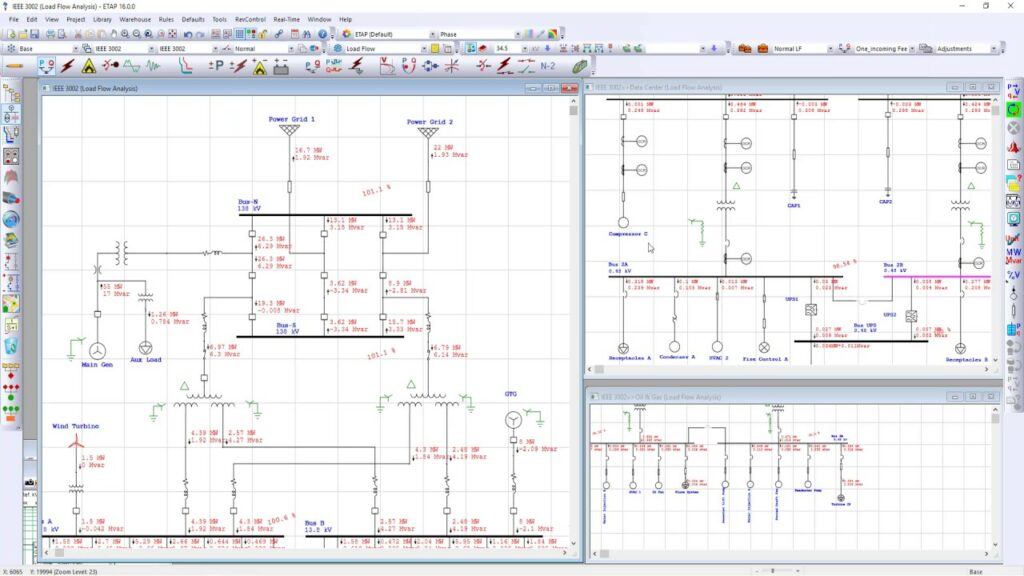Mastering Electrical Power Systems Analysis with ETAP: A Comprehensive Guide

Introduction: Electrical power systems are the backbone of modern society, supplying electricity to homes, businesses, industries, and infrastructure. Analyzing and optimizing these complex systems is essential to ensure reliability, safety, and efficiency. ETAP (Electrical Transient Analyzer Program) is a leading software solution for electrical power systems analysis, offering a wide range of tools and capabilities for modeling, simulation, and optimization. In this comprehensive guide, we will explore the fundamentals, methodologies, and advanced techniques for using ETAP to analyze electrical power systems, covering everything from system modeling to transient stability analysis.
Section 1: Understanding Electrical Power Systems Analysis
1.1 Overview of Electrical Power Systems: Electrical power systems comprise generators, transformers, transmission lines, distribution networks, and loads interconnected to deliver electricity from generation sources to end-users. Analyzing power systems involves studying steady-state operation, transient behavior, fault conditions, and dynamic response to disturbances to ensure system stability, reliability, and performance.
1.2 Importance of Power Systems Analysis: Power systems analysis is crucial for designing, operating, and maintaining electrical networks efficiently and safely. It helps engineers identify potential issues, optimize system configurations, and mitigate risks associated with voltage instability, power quality issues, fault currents, and system protection coordination.
1.3 Role of ETAP in Power Systems Analysis: ETAP is a comprehensive software platform for electrical power systems analysis, offering modules for load flow analysis, short circuit analysis, transient stability analysis, protection coordination, arc flash analysis, and more. Its intuitive user interface, extensive library of components, and advanced simulation capabilities make it an indispensable tool for power engineers worldwide.
Section 2: Modeling Electrical Power Systems in ETAP
2.1 System Configuration and Topology: Engineers begin by creating a digital model of the electrical power system within the ETAP environment. They define the configuration, topology, and connectivity of components, including generators, transformers, buses, transmission lines, distribution feeders, switches, breakers, and loads, using ETAP’s graphical user interface.
2.2 Component Modeling: ETAP provides a comprehensive library of electrical components, including generators, motors, transformers, transmission lines, cables, circuit breakers, relays, protection devices, and control systems. Engineers select and configure components from the library, specifying parameters such as ratings, impedances, settings, and control logic to model specific system elements accurately.
2.3 Load Modeling: Modeling loads is essential for accurately simulating power consumption and distribution within the electrical network. Engineers define load characteristics, including active power, reactive power, voltage profiles, harmonic content, and dynamic behavior, using load models such as constant power, constant impedance, and dynamic load models available in ETAP.
Section 3: Performing Power Systems Analysis in ETAP
3.1 Load Flow Analysis: Load flow analysis, also known as power flow analysis, is a fundamental tool for studying steady-state operation and voltage distribution in electrical power systems. ETAP’s load flow module solves the power flow equations iteratively to determine bus voltages, branch currents, power losses, and system performance under normal operating conditions.
3.2 Short Circuit Analysis: Short circuit analysis assesses the effects of fault currents on system components and protection devices, helping engineers design protective relaying schemes and select appropriate equipment ratings. ETAP’s short circuit module calculates fault currents, fault levels, and voltage dips at various locations in the power system under different fault scenarios, including symmetrical and asymmetrical faults.
3.3 Transient Stability Analysis: Transient stability analysis evaluates the dynamic response of electrical power systems to disturbances such as faults, switching events, or load changes. ETAP’s transient stability module simulates system behavior over time, predicting rotor angle stability, frequency deviations, and voltage fluctuations during transient events to assess system stability and identify critical areas for improvement.
3.4 Protection Coordination Analysis: Protection coordination analysis ensures that protective devices, such as relays, circuit breakers, and fuses, operate correctly to isolate faults and minimize system downtime. ETAP’s protection coordination module evaluates relay settings, time-current characteristics, and coordination curves to optimize protection schemes, improve selectivity, and enhance system reliability.
Section 4: Advanced Techniques and Applications in ETAP
4.1 Harmonic Analysis: Harmonic analysis assesses the effects of harmonic distortion on power quality, equipment performance, and system reliability. ETAP’s harmonic analysis module calculates harmonic currents, voltages, and distortion levels, predicts resonance phenomena, and recommends mitigation measures such as harmonic filters, passive filters, or active filters to minimize harmonic distortion and comply with regulatory standards.
4.2 Arc Flash Analysis: Arc flash analysis evaluates the hazards associated with electrical arcs and explosions resulting from short circuits or equipment failures. ETAP’s arc flash analysis module calculates arc flash incident energy, arc flash boundaries, and personal protective equipment (PPE) requirements based on system parameters, fault currents, and equipment ratings, helping engineers assess and mitigate arc flash risks.
4.3 Renewable Energy Integration: With the increasing adoption of renewable energy sources such as solar, wind, and hydroelectric power, integrating renewable energy into electrical power systems has become essential. ETAP provides tools for modeling renewable energy sources, assessing grid integration challenges, and optimizing system configurations to maximize renewable energy penetration, grid stability, and energy efficiency.
Section 5: Best Practices and Tips
5.1 Model Verification and Validation: Verify and validate ETAP models by comparing simulation results with field measurements, test data, or analytical solutions. Conduct sensitivity analyses, uncertainty assessments, and model validation tests to ensure that simulation results are accurate, reliable, and representative of real-world behavior.
5.2 Data Management and Documentation: Organize ETAP projects systematically, maintain consistent naming conventions, and document assumptions, inputs, and results to facilitate collaboration, reproducibility, and knowledge transfer. Use ETAP’s project management features, report generation tools, and documentation templates to document model parameters, analysis methodologies, and validation procedures effectively.
5.3 Continuous Learning and Professional Development: Stay updated on the latest developments, best practices, and industry standards in electrical power systems analysis. Participate in training programs, webinars, conferences, and user forums to enhance your proficiency in ETAP, power system modeling techniques, and simulation methodologies.
Conclusion: ETAP is a powerful tool for electrical power systems analysis, offering engineers and designers a comprehensive platform for modeling, simulating, and optimizing complex electrical networks. By mastering the fundamental principles, advanced techniques, and best practices discussed in this guide, engineers can leverage ETAP to analyze system performance, assess reliability, and improve efficiency, safety, and sustainability of electrical power systems. With its intuitive interface, extensive library of components, and advanced simulation capabilities, ETAP empowers engineers to tackle challenging power system analysis tasks and make informed decisions to meet evolving energy demands and regulatory requirements.







